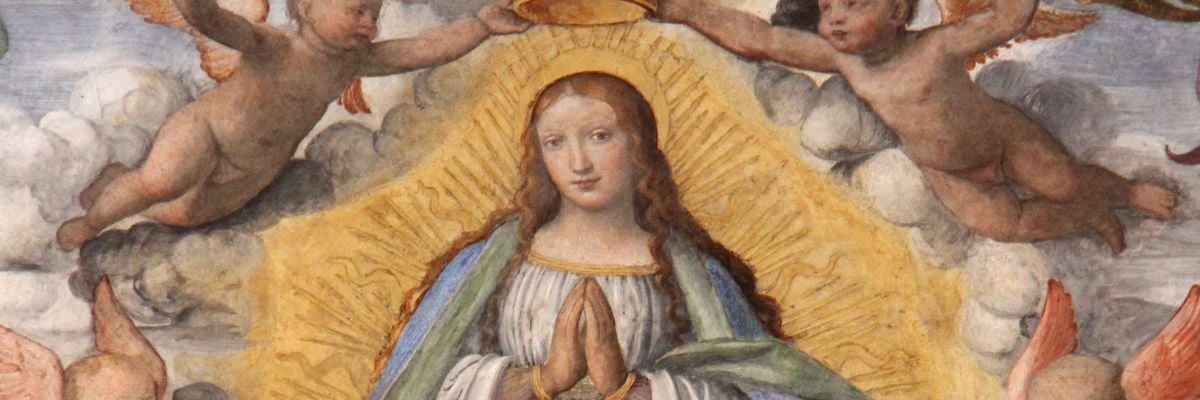
How can the Church teach that Mary was assumed into heaven, when the Scriptures say nothing about it?
When this question is posed, the Catholic might be tempted first to offer the scriptural evidence for the Assumption. But the person is not questioning the biblical evidence, he’s questioning the authority of the Church. So you must first address the authority of the Church and the role of Sacred Tradition in God’s plan of revelation.
If you asked a hundred Evangelical Christians, “What is the sure norm by which Christians know the teachings of Christ?” the unanimous answers would be to look only to the Bible. However, Paul advised Timothy to take as his norm the sound words that Paul spoke to him (2 Tim. 1:13). Timothy knew that even if a particular teaching was not written down, Christians were still expected to abide by it (2 Thess. 2:15) and to defer to the authority of Church leaders (Heb. 13:17). The only way a person could know what these unwritten binding traditions were was to keep their ear to the mouth of the Church. If the Church were merely a collection of saved individuals-none with any real authority over the others-then Scripture would not tout her as the pillar and foundation of truth (1 Tim. 3:15) whom we must listen to or be cut off (Matt: 18:17).
Nothing in scripture indicates what the canon of the New Testament should be, but this silence in no way hindered the Church from exercising the authority given to her by Christ (Matt. 16:15-19, 18:17-18) to decide the canon. Just as the fourth-century Church had authority to determine that twenty-seven books belonged in the New Testament, the twentieth-century Church had the authority to dogmatically define Mary’s Assumption into heaven.
But where is the biblical evidence?
Several Bible passages offer implicit evidence that Mary was assumed into heaven. Both Enoch and Elijah were assumed into heaven (Heb. 11:5, 2 Kgs. 2:11). Also, in Matthew 27:52-53 one can read about saints whose bodies left the grave after the Resurrection of Christ. The early resurrection of these saints anticipated the rising of those who die in faith, all of who will be assumed one day to receive their glorified bodies. Belief in the assumption of Mary is simply the belief that God granted her this gift early, as he appears to have done for others in Matthew 27:52-53.
The Scriptures also promise that those who suffer with Christ will be glorified with him (Rom. 8:17), so it is fitting that she whose heart was pierced through her Son’s suffering would receive her glorification in a unique manner. Paul calls Christians “God’s co-workers” (1 Cor. 3:9), and there was no co-worker of Christ who was linked so intimately in the work of salvation as was Mary.
But that’s circumstantial evidence. Face it, the Bible never mentions Mary’s Assumption.
Keep in mind that if Scripture does not record an event, it does not follow that the event did not happen. Scripture does not record Paul or Peter’s journey to Rome, and they were both martyred there while the Bible was still being written. With this in mind, it would be unscriptural and unreasonable to conclude that the dogma of Mary’s Assumption is false because it is not mentioned explicitly in Scripture.
There are numerous reasons why it is fitting that the Lord would assume Mary’s body into heaven. By becoming man, Jesus was born under the law (Gal. 4:4) and was bound to obey the commandment to honor his mother. The Hebrew word for “honor” does not imply mere courtesy, but the bestowal of honor and glory. By preserving Mary’s body from corruption, Jesus fulfills the command to honor his mother in a way that only a divine Son could. What person, if he had the power to prevent the corruption of his mother’s body, would not do so? The love of Jesus for his mother seems to be the strongest argument for her Assumption.
It is useful also to examine how God calls people to treat holy things in the Old Testament. The holiest object for the people of Israel was the Ark of the Covenant, because it contained the bread from heaven, the staff of Aaron, and the tablets of the law. It was laden in and out with gold and could only be approached by sanctified priests. One unfortunate soul dared to touch it, and despite his good intentions, it cost him his life (2 Sam. 6:6-7). God’s glory overshadowed this holy Ark, and Psalm 132:8 says of it, “Arise, O Lord, into thy resting place; thou and the ark which thou hast sanctified.”
In the book of Revelation we read, “Then God’s temple in heaven was opened, and the ark of his covenant was seen within his temple” (Rev. 11:19). “And a great portent appeared in heaven, a woman clothed with the sun, with the moon under her feet, and on her head a crown of twelve stars; . . . she brought forth a male child, one who is to rule all the nations with a rod of iron” (Rev. 12:1,5). The arbitrary break here between chapters, done long after the Bible was written, makes it easy to overlook how John mentions the mother of the Messiah in conjunction with the Ark of the Covenant.
Considering God’s reverence towards an inanimate Ark, St. Robert Bellarmine asked a fitting question: “Who could believe that the ark of holiness, the dwelling of God, the temple of the Holy Spirit [i.e., Mary], crumbled into dust? I shudder at the very thought that the virginal flesh of which God was conceived and born, which nourished him and carried him should have turned to ashes or been given as food to worms.”
Doesn’t all of the historical “evidence” for Mary’s Assumption come from apocryphal stories?
Historians-Catholic and non-Catholic-agree that there is a great deal of ancient material on the Assumption that is unreliable. A prime example of this is the Transitus Mariae stories, which were written as homilies in the fifth and sixth centuries. These are often fantastic and legendary accounts, devoid of historical accuracy. Some examples include the Obsequities of the Holy Virgin, and the text of Pseudo-Melito. But these apocryphal writings have no bearing on the Church’s dogma of Mary’s Assumption.
The Church Fathers provide a much more balanced approach. Epiphanius said in A.D. 377, “Let them search the scriptures. They will not find Mary’s death; they will not find whether she died or did not die; they will not find whether she was buried or was not buried. More than that: John journeyed to Asia, yet nowhere do we read that he took the holy Virgin with him. Rather, Scripture is absolutely silent [on Mary’s earthly end] because of the extraordinary nature of the prodigy, in order not to shock the minds of men. . . . Neither do I maintain stoutly that she died. . . .
“Did she die? We do not know. At all events, if she was buried, she had no carnal intercourse. . . . Or she remained alive, since nothing is impossible with God and he can do whatever he desires” (Panarion, haer. 78, nn. 10-11,23: G.C.S., 37, 461-462; 474).
Neither Jerome, Origen, Athanasius, Ambrose, nor Augustine contested Epiphanius in what he had written regarding Mary’s miraculous passing, and Ephraem (d. 373) described Mary as having been glorified by Christ and carried through the air to heaven (Cf. Ephraem, De nativitate domini sermo 12, sermo 11, sermo 4; Opera omni syriace at latine, Vol. 2, 415). Throughout history, there have been very few opponents in the Church of Mary’s Assumption. No one seemed ready to claim that she corrupted. In fact, the first opposition to the Assumption cannot be found until Ambrosius Autpertus of the eighth century.
From this faith of the Church, Christians began to celebrate the feast of Mary’s unique passing. Like the fruit from a tree, the liturgy is the result of doctrine, not the source of it. By the end of the fourth century, the feast of the Dormitio or Koimesis, which celebrated Mary’s death, resurrection, and Assumption, was celebrated throughout the East. A feast celebrating Mary’s entrance to heaven, “The Memory of Mary,” also began around the fourth century. The significance of these early feasts cannot be overlooked, as they are testimony to the truths that the Church knew to be true. Christians would not initiate feasts throughout the Church that were ideas on the fringes of Catholic thought.
One reason why it is difficult to assess where Mary’s last days were is because she left no remains. The early Church prized the relics of early Christians, as can be seen by reading The Martyrdom of Polycarp. However, no one claimed to have Mary’s remains, which would have been prized above all others. There is no historical reference to the relics of Mary, the corruption of Mary, or the place where her body lies. A skeptic who denies Christ’s Resurrection should be asked to find evidence of the remains of Christ, and the same challenge can be extended to whoever denies Mary’s Assumption.



